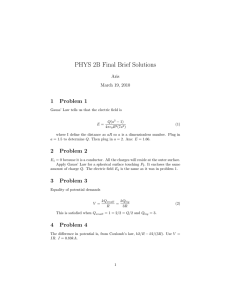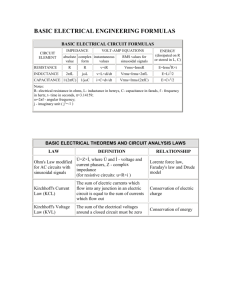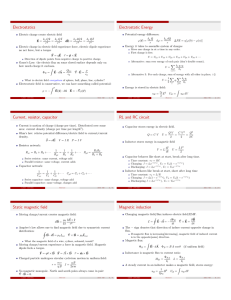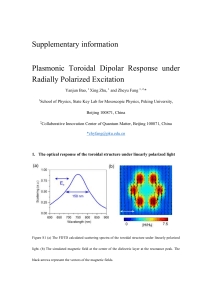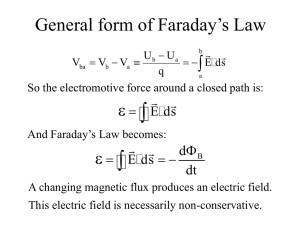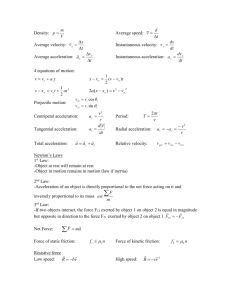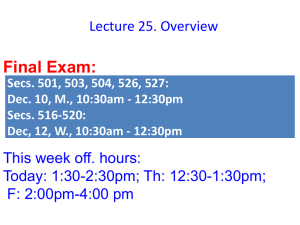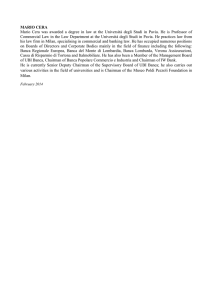MExxxElectromagnetic NDE
advertisement
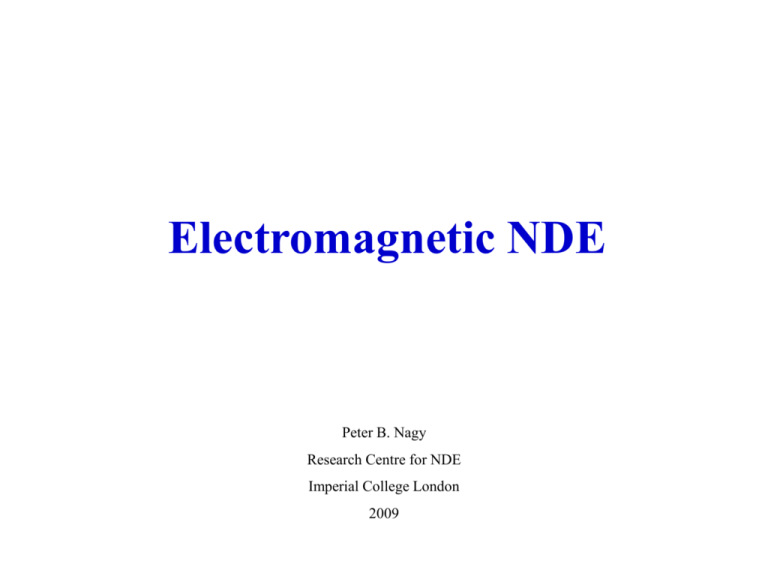
Electromagnetic NDE Peter B. Nagy Research Centre for NDE Imperial College London 2009 Aims and Goals Aims 1 2 The main aim of this course is to familiarize the students with Electromagnetic (EM) Nondestructive Evaluation (NDE) and to integrate the obtained specialized knowledge into their broader understanding of NDE principles. To enable the students to judge the applicability, advantages, disadvantages, and technical limitations of EM techniques when faced with NDE challenges. Objectives At the end of the course, students should be able to understand the: 1 2 3 4 fundamental physical principles of EM NDE methods operation of basic EM NDE techniques functions of simple EM NDE instruments main applications of EM NDE Syllabus 1 Fundamentals of electromagnetism. Maxwell's equations. Electromagnetic wave propagation in dielectrics and conductors. Eddy current and skin effect. 2 Electric circuit theory. Impedance measurements, bridge techniques. Impedance diagrams. Test coil impedance functions. Field distributions. 3 Eddy current NDE techniques. Instrumentation. Applications; conductivity, permeability, and thickness measurement, flaw detection. 4 Magnetic measurements. Materials characterization, permeability, remanence, coercivity, Barkhausen noise. Flaw detection, flux leakage testing. 5 Alternating current field measurement. Alternating and direct current potential drop techniques. 6 Microwave techniques. Dielectric measurements. Thermoelectric measurements. 7 Electromagnetic generation and detection of ultrasonic waves, electromagnetic acoustic transducers (EMATs). 1 Electromagnetism 1.1 Fundamentals 1.2 Electric Circuits 1.3 Maxwell's Equations 1.4 Electromagnetic Wave Propagation 1.1 Fundamentals of Electromagnetism Electrostatic Force, Coulomb's Law Fe Fe y Q1 x z r Q2 Fe Q1 Q2 er 4 r 2 Fe Coulomb force Q1, Q2 electric charges ( ne, e 1.602 10-19 As) er unit vector directed from the source to the target r distance between the charges ε permittivity (ε0 ≈ 8.85 10-12 As/Vm) dFe Q1 dQ2 x ex 4 r 2 r dQ2 q dA, dA 2 d Q1 q x e x d Fe 2 0 r3 dρ ρ r x Q1 Fe independent of x dQ2 infinite wall of uniform charge density q d r 2 x2 , dr Fe r r 2 x2 Q1 q x e x dr 2 2 rxr Fe Q1 q e x 2 r Electric Field, Plane Electrodes Fe E Qt y infinite wall of uniform charge density q Qt x Fe z Fe E Qt q e x 2 q ex 2 charged parallel plane electrodes Q A +Q E -Q E q l q ex Q A Electric Field, Point Sources Fe E Qt monopole dipole E1 +Qs +Qs E2 d +Qs -Qs -Qs E1 Fe Qs Qt er 4 r 2 E1 Qs d 2 r 3 E Qs er 4 r 2 E2 Qs d 4 r 3 Electric Field of Dipole z Ez ER θ r+ E P r +Qs r R d -Qs E E z e z ER e R r 2 z 2 R2 z r cos Qs z d /2 z d /2 Ez 4 ( z d / 2)2 R 2 3 / 2 ( z d / 2)2 R 2 3 / 2 Qs R R ER 4 ( z d / 2)2 R 2 3 / 2 ( z d / 2)2 R 2 3 / 2 R r sin Ez Qs d 3cos2 1 3 4 r ER 3Qs d sin 2 8 r 3 Electric Dipole in an Electric Field pe Q d Q d ed E E eE E Fe E Q +Q Te d Fe d E Q Fe Fe Te pe E pe -Q pe electric dipole moment Q electric charge d distance vector E electric field Fe Coulomb force Te twisting moment or torque Electric Flux and Gauss’ Law D q D E dS e S dS D d D dS dS D dS S q dV Qenc Qenc V closed surface S q charge (volume) density D electric flux density (displacement) E electric field (strength, intensity) ε permittivity electric flux Qenc enclosed charge Electric Potential dW Fe d B WAB Q E d A U U B U A WAB E B d A U VQ Fe B V VB VA E d Q A W work done by moving the charge Fe Coulomb force ℓ path length E electric field Q charge U electric potential energy of the charge V potential of the electric field Capacitance Q CV C capacitance V voltage difference Q stored charge +Q +Q A +Q E d E E l -Q -Q -Q S+ V V+ V- E d S- C Q V D Q A D E V E C A Current, Current Density, and Conductivity dA E dQ dt I current Q transferred charge I J dA t time dI J dA J current density dQ ne v d dA dt A cross section area n number density of free electrons vd mean drift velocity m vd eE v e charge of proton m mass of electron τ collision time Λ free path 1 2 3 mv k T 2 2 v thermal velocity k Boltzmann’s constant T absolute temperature σ conductivity I J ne v d J ne2 E E m Resistivity, Resistance, and Ohm’s Law I A + V _ d S+ V V+ V- E d SLJ V 0 L d d I 0A IR V R I dU dQ P V VI dt dt V voltage I current R resistance P power σ conductivity ρ resistivity L length A cross section area L d R 0A L d 0 A 1 L R i i Ai R L A Magnetic Field Fe Q E Fm Q v B Q dv B Fm F Q (E v B) F Lorenz force v velocity B magnetic flux density Q charge B pm N I A pm +I pm -I magnetic dipole moment (no magnetic monopole) N number of turns I current A encircled vector area Magnetic Dipole in a Magnetic Field pm N I A pm B Qv R 2 e r ev 2 R pm Fm pm Fm Q v B -I Tm +I Fm Q NI 2 R v 1 Q R v 2 1 R Fm 2 Tm p m B A R2 1 2 2 1 Tm cos R Fmd R Fm 2 0 2 pm magnetic dipole moment Q charge v velocity R radius vector B magnetic flux density Fm magnetic force Tm twisting moment or torque Magnetic Field Due to Currents E Coulomb Law: Qs Qs er r 4 r 2 4 r 3 D E Biot-Savart Law: dH Id I e er d r 4r2 4 r3 H Id e er 4r2 B H H dℓ I r d H magnetic field μ magnetic permeability Ampère’s Law D dS Qenc Gauss’ Law: S H J Ampère’s Law: H ds I enc dH Biot-Savart Law: infinite straight wire dH dℓ r ℓ R s Id e er 4r2 Id R IR d e e 4 ( 2 R 2 )3 / 2 4r2 r H H d IR d I 2 2 0 ( R 2 )3 / 2 2 R Ampère’s Law: I H ds H 2 R I H I 2 R Induction, Faraday’s Law, Inductance E B B t Є B dS t S B dS S Є E ds d Є dt V Є N I N V dI dt L N2 IL N induced electric field B magnetic flux density t time Є induced electromotive force s boundary element of the loop Φ magnetic flux S surface area of the loop μ magnetic permeability N number of turns I current Λ geometrical constant L (self-) inductance d dt N I V L E Electric Boundary Conditions Gauss' law: Faraday's law: D q E xn B t xn medium II medium II DII II II DII,n DI,t boundary DII,t DI,n EII EI,t xt DI I EII,n EII,t I EI,n EI medium I DI,n DII,n I EI,n II EII,n medium I tan I tan II I II EI,t EII,t tan I EI,n tan II EII,n tangential component of the electric field E is continuous normal component of the electric flux density D is continuous xt Magnetic Boundary Conditions Gauss' law: Ampère's law: B 0 H J xn D t xn medium II medium II BII II II BII,n BI,t boundary BII,t BI,n HII HI,t xt BI I HII,n HII,t I HI,n HI medium I BI,n BII,n I H I,n II H II,n medium I tan I tan II I II H I,t H II,t tan I H I,n tan II H II,n tangential component of the magnetic field H is continuous normal component of the magnetic flux density B is continuous xt 1.2 Electric Circuits Electric Circuits, Kirchhoff’s Laws Kirchhoff’s loop rule (voltage law): R1 + Є _ V0 E d 0 R2 I V2 V1 V4 V3 Vi 0 R3 R4 Є electromotive force Vi potential drop on ith element Kirchhoff’s junction rule (current law): R1 Є I2 I1 Qenc D dS R2 S I4 + _ Ii 0 R3 R4 Ii current flowing into a junction from the ith branch Circuit Analysis Kirchhoff’s Laws: V1 V4 V0 0 R1 Є + _ V0 V1 R2 I2 I1 I4 V4 V2 V2 V3 V4 0 V3 R3 V1 V2 V4 0 R1 R2 R4 V2 V3 0 R2 R3 R4 Loop Currents: R1 + Є _ I2 I1 R2 i1 R1 (i1 i2 ) R4 V0 0 I4 i2 i1 R4 R3 i2 R2 i2 R3 (i1 i2 ) R4 0 DC Impedance Matching Rg Vg + _ V R W QV P IV V2 P I V I2 R I P Vg Rg R Vg2 V and , Rg (1 )2 R Vg R Rg R where R Rg Vg2 1 dP d Rg (1 )3 Pmax Vg2 4 Rg when R Rg AC Impedance I I V L V Z dI dt I V RI V V iL I Z V V V R I Z V 1 I i C V (t ) V0 ei (t V ) V0 eit V0 V0 ei V V Re V I (t ) I 0 ei (t I ) I 0 eit I 0 I 0 ei I I Re I V Z 0 R i X Z eiZ I0 V Z 0 I0 R2 X 2 arg(Z ) Z V - I tan -1 X R 1 I dt C AC Power complex notation correspondence I (t ) I 0 cos(t I ) I (t ) I 0 ei (t I ) I 0 eit I Re I V (t ) V0 cos(t V ) V (t ) V0 ei (t V ) V0 eit V Re V real notation P I (t )V (t ) P 1 I 0 V0 cos(I V ) 2 P 1 1 I (t )V * (t ) I 0 V0* 2 2 P 1 I0 V0 ei (I V ) 2 reminder: cos( ) cos cos sin sin cos( ) cos cos sin sin 1 1 cos( ) cos( ) cos cos 2 2 ei cos i sin P Re P AC Impedance Matching Zg Vg V Z P Re P Vg2 1 Z* * P Re I V Re * 2 2 ( Z Z )( Z Z ) g g Zg Z * P Rg R , Xg X Rg i X g Re 2 2 4 Rg Vg2 Pmax Vg2 8 Rg 1.3 Maxwell's Equations Vector Operations ey ez x y z Nabla operator: ex Laplacian operator: 2 Gradient of a scalar: e x Curl of a vector: a A 2 2 2 x 2 y 2 z 2 ey ez x y z A dℓ e S lim S 0 S Ay A Ay Ax Ax Az A e x z ey ez z x y z y x Divergence of a vector: A dS Ax Ay Az A lim S x y z V 0 V Laplacian of a scalar: 2 2 2 2 x 2 y 2 z 2 Laplacian of a vector: 2 A 2 Ax e x 2 Ay e y 2 Az e z Vector identity: ( A ) ( A ) 2 A Maxwell's Equations Field Equations: Ampère's law: Faraday's law: D t B E t H J Gauss' law: D q Gauss' law: B 0 Constitutive Equations: conductivity J E permittivity D E permeability B H 0 r (ε0 ≈ 8.85 10-12 As/Vm) 0 r (µ0 ≈ 4π 10-7 Vs/Am) 1.4 Electromagnetic Wave Propagation Electromagnetic Wave Equation E E0 eit Harmonic time-dependence: and H H 0 eit Maxwell's equations: E H J B i H t ( E) i ( i ) E D ( i )E t ( H) i ( i ) H ( A ) ( A ) 2 A 2E i ( i ) E E 0 H 0 Wave equations: 2H i ( i ) H ( 2 k 2 ) E 0 ( 2 k 2 ) H 0 k 2 i ( i ) Example plane wave solution: E E y e y E0 ei (t k x ) e y H H z e z H 0 ei (t k x ) e z Wave Propagation versus Diffusion k 2 i ( i ) k Propagating wave in free space: wave number c k E E0 ei(t x / c ) e y 1 0 0 c c H H 0 ei(t x / c ) e z wave speed Propagating wave in dielectrics: 1 0 0 r cd n n c cd r refractive index Diffusive wave in conductors: k i 1 i 1 f δ E E0 e x / ei (t x / ) e y H H 0 e x / ei (t x / ) e z standard penetration depth Intrinsic Wave Impedance E E y e y E0 ei (t k x ) e y H H z e z H 0 ei (t k x ) e z k i ( i ) H J H D ( i )E t H z e y i k H 0 ei (t k x) e y x E0 H0 i i Propagating wave in free space: 0 0 377 0 Propagating wave in dielectrics: 0 0 0 r n i 1 i Diffusive wave in conductors: Polarization Plane waves propagating in the x-direction: E E y e y Ez e z E y 0 ei (t k x) e y Ez 0 ei (t k x) e z H H z e z H y e y H z 0 ei (t k x) e z H y 0 ei (t k x) e y 0 E y0 H z0 E y 0 E y 0 ei y z Ez Ez 0 H y0 E z 0 E z 0 e i z z E Ey linear polarization y z 0º (or 180º) z E y E y elliptical polarization y circular polarization y z 90º (or 270º) Reflection at Normal Incidence y I medium II medium incident x reflected Ei Ei0 ei (t kI x ) e y Hi Ei0 i (t k x ) I e ez I transmitted Er Er0 ei (t kI x ) e y E H r r0 ei (t kI x) e z I E t Et0 ei (t kII x ) e y Ht Et0 i (t k x) II e ez II Boundary conditions: E y ( x 0 ) E y ( x 0 ) Ei0 Er0 Et0 H z ( x 0 ) H z ( x 0 ) H i0 H r0 H t0 Ei0 Er0 E t0 I I II R Er0 I II Ei0 II I T Et0 2 II Ei0 II I Reflection from Conductors y I dielectric II conductor incident x reflected II transmitted “diffuse” wave 1 0 f i I 0 n R II I 1 II I negligible penetration almost perfect reflection with phase reversal Axial Skin Effect y propagating wave E E0 F ( x) eit e y H H 0 F ( x) eit e z diffuse wave F ( x ) e x / e i x / x dielectric (air) δ standard penetration depth 1 f conductor Normalized Depth Profile, F 1 magnitude real part 0.8 0.6 0.4 0.2 0 -0.2 0 1 2 Normalized Depth, x / δ 3 Transverse Skin Effect r current, I current density E z E0 J 0 (k r ) 2a z conductor rod Normalized Current Density, J/JDC magnitude, J DC k 2 i I a2 8 7 E0 a/δ = 1 a/δ = 3 a/δ = 10 6 5 Jn k 1 i 1 f kI 2 a J1(k a) nth-order Bessel function of the first kind 4 3 J z (r ) 2 1 0 0 0.2 0.4 0.6 Normalized Radius, r/a 0.8 1 I k a J 0 (k r ) a 2 2 J1(k a) Transverse Skin Effect r Z current density current, I 2a V R iX I z conductor rod Z R0 G (k a ) R0 A a 2 Normalized Resistance, R/R0 100 G ( ) 10 R 1 R R0 J 0 ( ) 2 J1() lim G a / lim R 0.1 0.01 a / 0.1 1 Normalized Radius, a/δ 10 100 a (1 i) 2 2a
